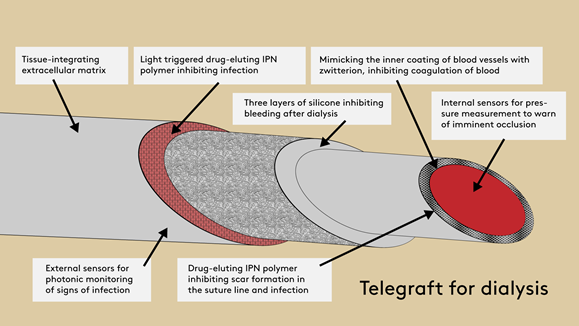Background
With 10 % of the worldwide population affected by chronic kidney disease and millions of deaths each year due to lack of access to healthcare treatment, there is a dire need for innovative and accessible devices which will help patients safely receive dialysis from home.
Through this international project, researchers and practitioners from eleven partner institutions across seven European countries seek to develop a revolutionary artificial blood vessel that is prevented from closing or becoming infected. The need is justified by the fact that up to 70% of current arteriovenous grafts fail in the first year after implantation. This is primarily due to thrombosis, luminal scar formation, and infection. When using the new arteriovenous graft TeleGraft for dialysis, an artificial blood vessel can be used relatively easily and quickly for safe home dialysis and bypass surgery.
Solution
TeleGraft stands for telemonitoring of home dialysis utilizing a smart biomimetic arteriovenous graft. It will comprise two diagnostic tools to monitor and prevent device complication. Pressure transmitters will be used to monitor blood flow and optical sensors to detect inflammation and infections. The data will be processed by AI machine learning models and displayed in an easy-to-understand dashboard for healthcare professionals. The data will allow online telemonitoring as well as consultations by remote healthcare professionals. This will make home dialysis safe for patients, even in areas with poor infrastructure, where patients live far from hemodialysis clinics.
The TeleGraft system will be demonstrated in an operational environment through a 2-stage randomized clinical trial enrolling 60 patients at 5 hospitals across Europe (in Denmark, Sweden, Lithuania, Spain, and Germany) and through a home hemodialysis field study.
Expected results
In low- and middle-income countries, TeleGraft will substitute complicated and expensive kidney transplantation and allow simpler and cheap implantation of arteriovenous graft for hemodialysis.
In the longer term, TeleGraft used for dialysis will:
- Improve performance of grafts for dialysis
- Enable patients to receive dialysis at home
- Become a sustainable and affordable solution for smart active implants
- Allow for remote monitoring of complications and real-time online detection of potential device failures
- Allow transferal to bypass surgery
To access summaries of the project's outcomes so far, including deliverables and milestones achieved, visit the European Commision's Community Research and Development Information Service (CORDIS) site for TeleGraft.

